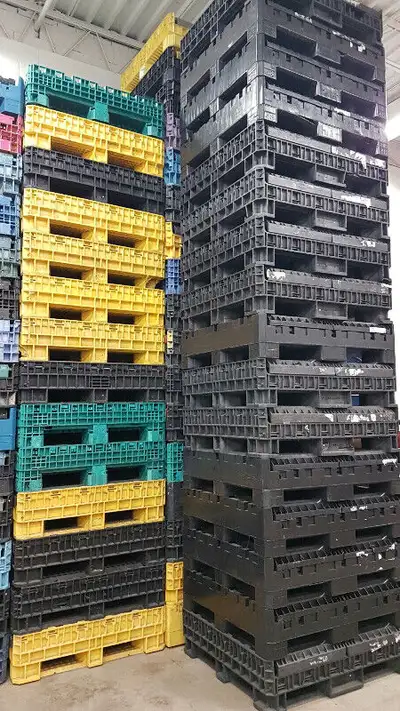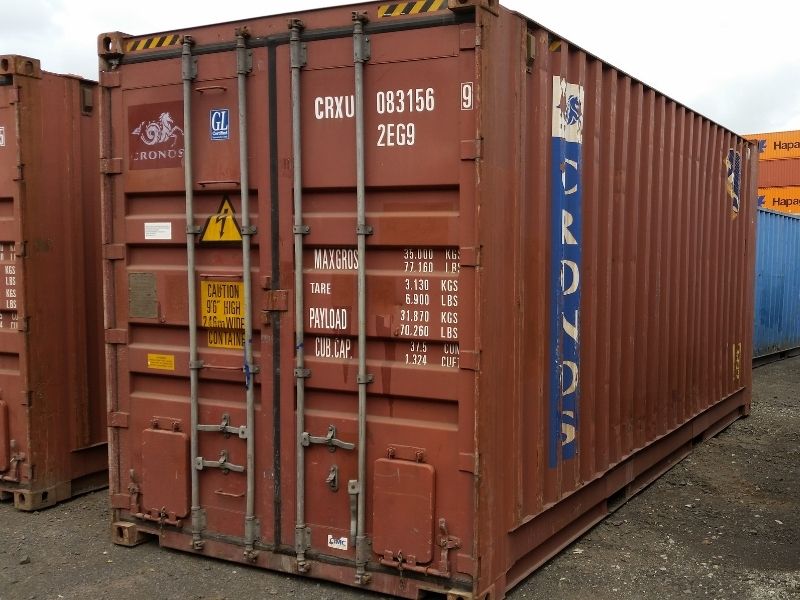How used bulk containers improve product handling across industries
Wiki Article
The Ultimate Overview to Selecting the Right Bulk Containers for Your Service Requirements
Choosing the suitable mass containers is important for any type of business that depends on effective logistics. Various kinds of containers exist, each made for details products and applications. Elements such as dimension, material compatibility, and governing requirements play a significant duty in this decision-making process. Understanding these aspects can result in enhanced functional performance. Nevertheless, many organizations neglect vital facets that might improve their overall performance and sustainability. What are these considerations?Understanding Various Sorts Of Mass Containers
Mass containers act as crucial tools for companies seeking effective storage and transport services. These containers can be found in various types, each designed to satisfy specific operational needs. One usual kind is the intermediate mass container (IBC), which is optimal for granulated and liquid materials, supplying a balance of ability and ability to move. Another preferred alternative is the mass bag, or FIBC, appropriate for completely dry, flowable items. These adaptable containers are light-weight and can be quickly transferred and stored. For larger materials, stiff mass containers are commonly used, giving resilience and stability for risk-free handling. Furthermore, there are specific containers customized for harmful products, making sure compliance with security policies. Comprehending the unique qualities of these bulk container types permits companies to make informed decisions that enhance logistics and lower costs. By picking the ideal container, firms can enhance their functional performance and simplify their supply chain processes.Key Product Factors To Consider for Bulk Containers
When choosing bulk containers, it is vital to contemplate the products made use of in their construction. Aspects such as longevity, stamina, and chemical compatibility play a vital duty in ensuring the containers meet details operational needs. Additionally, weight and portability issues can affect both performance and transportation logistics.Material Sturdiness and Strength
Sturdiness and stamina are important consider picking materials for mass containers, as they directly affect the container's ability to stand up to various ecological conditions and managing processes. Products such as high-density polyethylene (HDPE), polypropylene, and stainless-steel are commonly preferred for their durable properties, using resistance to abrasion, temperature level, and impact changes. The choice of material also impacts the total lifespan of the container; stronger materials normally cause much less frequent substitutes, resulting in set you back financial savings over time. Furthermore, the weight of the material can influence delivery prices and convenience of handling. Organizations must consider their specific functional atmospheres and the possibility for wear and tear to ensure peak sturdiness and stamina in their bulk container option.Chemical Compatibility Aspects
Understanding chemical compatibility is essential for choosing bulk containers, as the materials used need to stand up to the certain substances they will certainly hold. Different elements affect compatibility, consisting of the chemical nature of the contents, temperature, and duration of storage space. For example, harsh chemicals may require containers made from stainless steel or specialized plastics that stand up to degradation. In addition, responsive compounds can create warm or gases, requiring vented or pressure-rated containers. The selection of container product, whether polycarbonate, polyethylene, or metal, need to straighten with the chemical residential or commercial properties of the stored substances to avoid leakages or violations. Eventually, a detailed examination of these compatibility factors ensures safe handling and storage, shielding both employees and the environment while maintaining product integrity.Weight and Portability Issues
Selecting bulk containers involves not only assessing chemical compatibility yet additionally thinking about weight and transportability. Businesses need to analyze the simplicity of handling and transportation to maximize efficiency. Lightweight products like high-density polyethylene (HDPE) or light weight aluminum can facilitate much easier motion and decrease delivery prices. Conversely, heavier containers may provide boosted toughness however can hinder flexibility, especially in atmospheres calling for regular moving. In addition, the design of the container should permit for convenient training and piling, making sure ergonomic security for employees. Companies must additionally consider the infrastructure offered for transport; for instance, containers suitable with forklifts or pallet jacks can improve procedures. Inevitably, the ideal balance in between weight and transportability straight influences operational performance and cost efficiency.Sizing Your Mass Containers for Ideal Effectiveness
When sizing bulk containers, businesses need to carefully evaluate the dimensions needed to accommodate their certain items. In addition, weight capacity is an important factor that affects performance and safety and security during transport and storage space. Effective sizing not only makes best use of room however also maximizes operational operations.Identifying Container Capacities
Selecting the appropriate measurements for bulk containers is essential for maximizing effectiveness in storage and transport. Companies must examine their certain requirements, taking into account variables such as offered room, the nature of the products being saved, and the approaches of transport made use of. Accurate dimensions assure that containers fit preferably in warehouses and automobiles, lessening lost area and decreasing dealing with time. Requirement dimensions can use comfort, yet personalized measurements could be needed for special demands or to fit certain items. Additionally, it is necessary to review piling abilities and availability, as these elements influence total functional performance. Inevitably, the appropriate dimensions cause improved organization and streamlined logistics, benefiting the general efficiency of business.Weight Ability Considerations
Understanding weight ability is vital for organizations intending to enhance their bulk container effectiveness. The weight capacity of a container directly influences storage space capacities, transport logistics, and overall functional prices. Choosing containers with the ideal weight limits assures that organizations can securely keep and transfer their products without taking the chance of damages or compliance issues. Overloading containers can cause architectural failures, while underutilizing capability cause lost sources. When choosing containers, it is important for organizations to assess their item weights and take into consideration any kind of regulatory needs. In addition, elements such as the type of material, intended usage, and ecological problems must additionally influence weight capacity decisions. By evaluating these elements, services can improve efficiency and guarantee a streamlined supply chain.Governing Compliance and Security Specifications

Governing conformity and safety criteria play a necessary function in the selection of bulk containers for services. Organizations must assure that their containers meet various guidelines established by local, nationwide, and international authorities. These requirements usually refer to material safety, architectural stability, and proper labeling, which aid stop used collapsible containers accidents and assure the secure transport of products.
Additionally, adherence to industry-specific guidelines, such as those from the Fda (FDA) or the Occupational Safety And Security and Wellness Management (OSHA), is crucial for firms taking care of harmful materials or foodstuff. Non-compliance can result in fines, legal issues, or damage to a business's credibility.
Services need to also think about the container's compatibility with the materials being saved or moved to avoid contamination or chemical responses (used bulk containers). To sum up, comprehending and executing governing compliance and safety requirements is essential for the efficient and liable use of mass containers
Sustainability Alternatives for Eco-Friendly Bulk Containers

Firms are also exploring choices made from recycled products, which not just preserve resources yet likewise support the reusing industry. Technologies in design permit for lighter containers that call for less power to transport, even more boosting sustainability. By integrating these environmentally friendly mass container alternatives, services can demonstrate their commitment to ecological stewardship while fulfilling consumer need for sustainable methods. This change not just helps the planet but can likewise enhance brand name online reputation and customer commitment.
Cost-Effectiveness and Budgeting for Bulk Containers
While lots of businesses concentrate on sustainability, cost-effectiveness continues to be a critical element when picking bulk containers. Organizations should assess the initial purchase rate, along with long-lasting operational prices, to ensure economic feasibility. Factors such as reusability, sturdiness, and upkeep play a substantial duty in identifying general costs.Buying top quality containers may yield greater upfront prices yet can result in financial savings through lowered substitute rates and decreased waste. Furthermore, organizations ought to consider transport expenses and storage space effectiveness, as these can influence the general budget.

Regularly Asked Questions
Exactly how Do I Determine the Right Container for Hazardous Products?
To determine the ideal container for harmful materials, one need to review compatibility with the material, take into consideration the container's product, look for governing compliance, and assess capability and security attributes to ensure proper handling and storage space.Can Mass Containers Be Personalized for Details Products?
Yes, bulk containers can be personalized for certain items. used plastic containers. Different attributes, such as size, material, and design, can be customized to satisfy one-of-a-kind needs, ensuring perfect security and efficiency for transporting and storing different goodsWhat Is the Average Life-span of Various Mass Container Types?
The typical lifespan of bulk container kinds varies; plastic containers last 5-10 years, metal containers 10-20 years, and wood containers typically last 3-7 years, depending upon use, maintenance, and ecological problems.Exactly how Should I Tidy and Maintain Bulk Containers?
To clean up and keep bulk containers, one should frequently check for damages, eliminate deposit, laundry with ideal detergents, rinse extensively, and guarantee appropriate drying prior to storage space. Adhering to producer guidelines boosts durability and security during usage.Exist Rental Choices for Mass Containers Available?
Yes, countless business supply rental options for bulk containers, offering versatility for organizations. These rentals can accommodate different needs, enabling companies to take care of stock effectively without the commitment of buying containers outright.Longevity and stamina are vital factors in choosing materials for bulk containers, as they directly influence the container's capability to endure numerous environmental problems and handling procedures. Understanding chemical compatibility is vital for picking bulk containers, as the products used need to stand up to the specific compounds they will certainly hold. Recognizing weight ability is important for organizations intending to maximize their mass container efficiency. Governing compliance and security standards play a crucial function in the option of bulk containers for companies. While many organizations concentrate on sustainability, cost-effectiveness continues to be a critical factor when choosing mass containers.
Report this wiki page